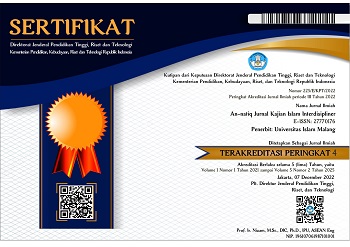PERILAKU PENGGUNA TIKTOK DALAM INTERAKSI LAWAN JENIS PERSPEKTIF AL-QURAN (KAJIAN QS. AL-AHZAB AYAT 32, 33, DAN 59)
DOI:
https://doi.org/10.33474/an-natiq.v2i2.15106Keywords:
Character Education, Muslim Women, Tik Tok, Opposite-Sex Interactions.Abstract
Negative characters have been displayed by the Indonesian people under the pretext of being right to do including Muslim women who began to show their expertise in swaying to the audience through the Tik Tok application, this is certainly far from the Muslimah character contained in the Qur'an, especially QS. AL-Ahzab verses 32, 33, and 59. So as to invite the creation of interaction of the opposite sex that should not be. This research is a literature study or library research conducted through review and analysis of data relevant to books, e-books, journals, and other literature as data sources. The results of the study are that the use of Tik Tok applications without purpose and just follow the trend so that it always looks current has a less good and detrimental impact. The impact of the dance causes Muslimah aurat to be seen easily, especially curves, encrusted, to invite slander that can harm themselves. While men must always keep their views in order to analyze the emergence of interactions that should not be done between the opposite sex. To stay away from these things as Muslims need to understand the values contained in the teachings of Islam.References
Abdul Baqi, M. F. (2010). Kumpulan Hadits Shahih Bukhari Muslim (J. Manik, Ed.; 13th ed.). Darul Hadits Qahirah.
Al-Umari, S. bin A. (2006). Mutiara Pilihan Syarah Shohih Muslim Petikan Intisari Karya Monumental Imam An-Nawawi (M. Albani & M. A. Qohhar, Eds.; 1st ed., Vol. 1). Al-Qowam.
Arifuddin, A. (2019). Pakaian Muslimah dalam Perspektif Hadis dan Hukum Islam. DIKTUM: Jurnal Syariah Dan Hukum, 17(1). https://doi.org/10.35905/diktum.v17i1.664
Faruqi, A., & Maghfirah, L. (2020). Etika Berhias Bagi Wanita Menurut Al-Qur’an Surat Al-Ahzab Ayat: 33. JURNAL ILMU AL-QUR’AN DAN TAFSIR NURUL ISLAM SUMENEP, 5(1).
Husin, N. (2015). Suara Wanita (Tinjauan Mukhtalif al-Hadits). Jurnal Ushuluddin, 21(1).
Kesuma, S. (2018). Jilbab dan Reproduksi Identitas Mahasiswi Muslimah di Ruang Publik. MUKADIMAH: Jurnal Pendidikan, Sejarah, Dan Ilmu-Ilmu Sosial, 1(2). https://doi.org/10.30743/mkd.v1i2.513
Nordin, S., Noor, S. S. M., & Mohd Al’Ikhsan Ghazali. (2016). Fenomena Tabarruj Masa Kini dalam Kalangan Wanita Muslimah. Dialog Keamanan: Satu Sorotan Dari Kacamata Al-Quran, December.
Rohmawati, H. S. (2020). Busana Muslimah dan Dinamikanya di Indonesia. Jurnal Aqlam-Journal of Islam and Plurality, 5(1).
Salleh, N. (2021). Tabarruj and Muslimah’s Clothing Fashion at this Present. AKADEMIKA: Journal of Southeast Asia Social Sciences and Humanities, 91(1). https://doi.org/10.17576/akad-2021-9101-09
Syafriana Nasution, H. (2017). Wanita Bekerja dalam Pandangan Islam. Al Mufida Jurnal Ilmu-Ilmu Keislaman, 2(2).
Witcher, B. J. (2020). PENGARUH APLIKASI TIK TOK TERHADAP EKSPRESI KOMUNIKASI MAHASISWA UNIVERSITAS ISLAM NEGERI (UIN) SUNAN AMPEL SURABAYA TAHUN. Incare: International Journal of Educational Resources, 01(02).
Yazid, T. P., & Ridwan. (2017). Proses Persepsi Diri Mahasiswa Dalam Berbusana Muslimah. Jurnal Pemikiran Islam, 41(2).
Downloads
Published
How to Cite
Issue
Section
License
Copyright (c) 2022 Tulus Musthofa, Wanda Saputri Machmud

This work is licensed under a Creative Commons Attribution-NonCommercial-ShareAlike 4.0 International License.


























